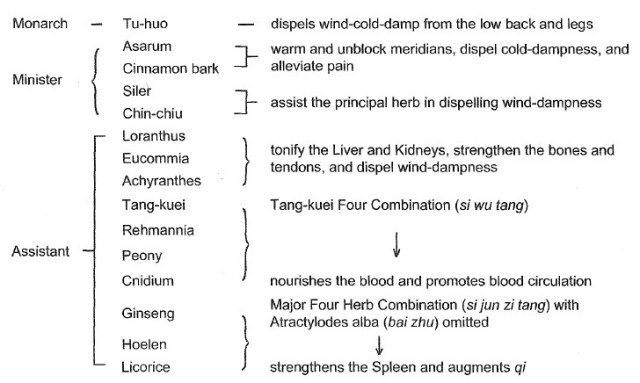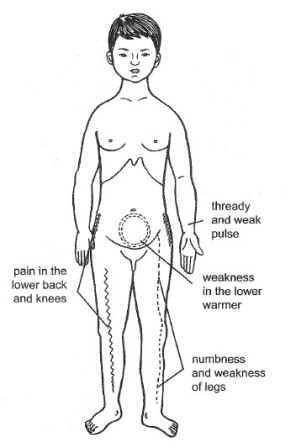Commonly Used Chinese Herb Formulas with Illustrations - Tu-huo and Loranthus Combination (Du Huo Ji Sheng Tang)
1605 獨活寄生湯 (Du Huo Ji Sheng Tang)
Tu-huo and Loranthus Combination
Angelica Pubescens and Sangjisheng Decoction
【Formulation】
|
Chinese Name |
Pharmaceutical name |
Pin Yin Name |
English Name |
|
獨活 |
Radix Angelicae pubescentis |
Du Huo |
|
|
秦艽 |
Radix Gentianae macrophyllae |
Qin Jiao |
|
|
防風 |
Radix Saposhnikoviae |
Fang Feng |
|
|
細辛 |
Radix Asari |
Xi Xin |
|
|
桂心 |
Cortex Cinnamomi |
Gui Xin |
|
|
桑寄生 |
Herba Taxilli |
Sang Ji Sheng |
|
|
杜仲 |
Cortex Eucommiae |
Du Zhong |
|
|
生地黃 |
Radix Rehmanniae |
Sheng Di Huang |
|
|
川牛膝 |
Radix Cyathulae |
Chuan Niu Xi |
|
|
當歸 |
Radix Angelicae sinensis |
Dang Gui |
|
|
白芍 |
Radix Paeoniae alba |
Bai Shao |
|
|
川芎 |
Rhizoma Chuanxiong |
Chuan Xiong |
|
|
人參 |
Radix Ginseng |
Ren Shen |
|
|
茯苓 |
Poria |
Fu Ling |
|
|
甘草 |
Radix Glycyrrhizae |
Gan Cao |
【Classic Literature Reference】
Qian Jin Yao Fang (Precious Major Formulas,652).
Compiler: Sun, Si-miao.
【Indications】
Traditional: Chronic Bi syndrome with Liver and Kidney deficiency, as well as qi and blood insufficiency, marked by aching low back and knees, stiffness, weakness, and numbness of lower extremities, an aversion to cold and attraction to warmth, shortness of breath, palpitation, a pale tongue with white coating, and a thready, weak pulse.
Modern: Chronic rheumatoid arthritis, osteoarthritis, sciatica, prolapse of intervertebral disc, poliomyelitis, scapulohumeral periarthritis, chronic pain in the low back and legs, and traumatic injury to the lower extremities.
Chronic Bi Syndrome with Liver and Kidney Deficiency
【Herbs and Actions】

Join our member to get full-text article! Join Free!
【Clinical Applications】for members only
【Caution and Contraindications】for members only
【Formulas Differentiation】for members only
【References】for members only
